Abstract
Vegetated swales, or bioswales, are among the most commonly used type of green infrastructure (GI) for managing stormwater in temperate climate regions. However, performance data on bioswale drainage technology applied to highly weathered soils (low fertility, high acidity, and erosion prone) in tropical and subtropical climates are still limited. Aimed at closing this gap, this research investigated the performance—assessed in terms of vegetation biomass, biodiversity and coverage of swale, the structural integrity of revetments, and erosion control potential—and cost effectiveness of five rolled erosion control products (RECPs) currently available on the market, in combination with herbaceous vegetation as the revetment of drainage swales, in tropical soils. Additionally, the research project evaluated the performance of a new preseeded RECP, the Preseeded Reinforcement Mat, for drainage in areas that are difficult to access. The performances of all six RECPs were generally adequate as bioswale revetments in the conditions investigated, with performance index values ranging from 6 to 10 in a 0 to 10 scale. At the same time, some RECPs were more conducive to the growth of regional herbaceous vegetation species, measured in terms of biodiversity, which ranged from 2 to 14 species in the different bioswales, and some were more cost effective than others, with costs ranging from 19% to 106% of the cost of concrete lined swales.
1. Introduction
In recent years, green infrastructure (GI) practices, which appeared in the 1990s, have become a very important tool in stormwater management [1] and erosion control [2] systems, in both rural and urban areas. According to Wise [3], GI strategies can be defined as an interconnected network of open spaces and natural areas—greenways, wetlands, parks, forest preserves, and native plant vegetation—that naturally manages stormwater, reduces the risk of floods, captures pollution, and improves water quality [4]. GI solutions such as green roofs, porous pavements, bioretention cells, and bioswales have become important bioengineering approaches due to their inherently lower cost in the phases of implementation and operation, and the fact that they are environmentally appropriate and generally aesthetically pleasing. Performance studies have been carried out to compare GI with gray infrastructure made of concrete and steel, and the combination of both green and gray infrastructure, which in some cases has led to better results [5]. For instance, the results of a life–cost analysis performed by Cohen [6] indicate that hybrid solutions involving concrete (gray) and green infrastructure were more cost effective than solutions with concrete only.
Bioswales, which are among the most commonly used GI, are vegetated water conveyance systems used to manage stormwater runoff [7]. The benefits of bioswales include the potential for retention and subsequent infiltration into the subsurface, and evapotranspiration, which when combined can reduce stormwater runoff by 90% for precipitations of up to 25 mm accumulated over 24 h [8]. Considering the high concentration of pollutants in the “first-flush” of precipitation [9,10,11], this potential for retention also leads to a reduction in water pollution [12].
In recent years, a robust amount of research has been carried out on the effectiveness of bioswales as a tool for the management of stormwater as well as carbon emission control [13,14,15,16,17,18], including large scale, citywide projects [19], and, therefore, data on stormwater runoff performance and long term hydrological simulations that integrate bioswales to other GI solutions have become widely available [20,21,22]. However, data on vegetation growth, erosion control potential, and guidelines for bioswales are not widely disseminated, and studies under tropical conditions are limited. This is important because vegetation cover in bioswales is directly connected to their hydrological performance, and poor vegetation establishment has been often associated with the reduced performance of bioswales [23]. In Brazil, for instance, there are no technical standards/technical guidelines that could guide the selection of materials and the type of vegetation to be used in the implementation of bioswales, for instance, what type of seeds would better develop in acidic, highly weathered, and low fertility soils under tropical conditions.
This research work focuses on researching the implementation and operation of vegetated swales with rolled erosion control products (RECPs) revetment, in rural areas under tropical conditions. More specifically, it targets study areas that are erosion prone, with multiple erosional ramifications, and that are situated close to the foundations of power transmission towers, such as that depicted in Figure 1. The removal of protective vegetation cover and soil disturbance during the installation of transmission towers have been reported as causing serious erosion and affecting the natural hydrology of disturbed sites [24,25].
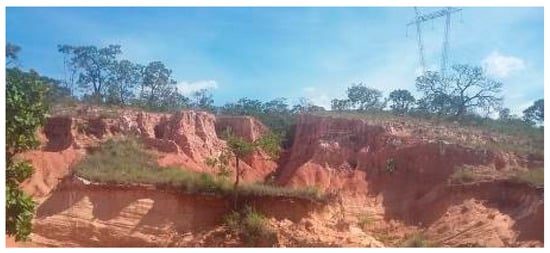
Figure 1.
Gully erosion due to poor land management practices near a transmission tower in the study area.
This work aims to contribute to the currently limited scientific literature on the use of RECPs as revetments for bioswales that could potentially lead to the development of technical standards/guidelines on the choice of materials and vegetation for revetments to be used under tropical conditions. In this sense, this work carried out a field scale comparative evaluation of six erosion control mats available on the market, as well as a recently developed product aimed for the revetment of swales, the preseeded reinforcement mat. The overarching hypothesis is that the added structural protection of bioswale beds with RECP will fortify the upper soil layer, enhancing the chances of vegetation to thrive in the low soil fertility conditions described above.
2. Materials and Methods
2.1. Study Area
The study areas, with a total length of 200 m, are located in the cities of São Gonçalo do Abaeté—Site 1—and Córrego Danta—Site 2—both in the state of Minas Gerais, Brazil (Figure 2). Both sites are located in the São Francisco basin which drains an area of 641.000 km2.
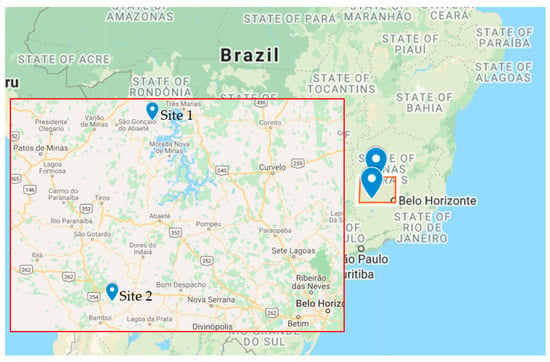
Figure 2.
Locations of study area: São Gonçalo do Abaeté—Site 1 (18.3415° S, 45.8328° W)—and Córrego Danta—Site 2 (19.8238° S, 45.9043° W).
2.2. Climate
The climate of Site 1 is, according to Köppen [26,27], characterized as Aw, which is typical of a tropical savannah, with a dry winter with an average precipitation of less than 60 mm. The rainy period starts in November and lasts until April (summer in the Southern Hemisphere). The average annual precipitation is 1317 mm. The predominant vegetation type is grasses, while bushes and undergrowth vegetation are also observed.
The climate for Site 2 is also characterized as Aw, with an average annual precipitation of 1566 mm and at least 70% or more of annual precipitation occurring in the warmest six months [28].
2.3. Soils
Soils of the study area, “Cerrado Biome”, originated from thick layers of sediments dating back to the Tertiary. They are characterized by a soil profile of a depth of around 10–25 m, a red or yellowish red color, porous, permeable, well drained, and highly weathered [29,30].
The soil color is imparted by coatings of very fine particles of humified organic matter, iron hydroxides, iron oxides, and sometimes manganese oxides. Manganese oxide minerals, although less prevalent than iron oxides in soils, commonly have an even stronger pigmenting effect upon soil. Iron oxides impart a characteristic yellowish (goethite) or red color (hematite). The color can be quantified by visual comparison to color charts, such as the Munsell soil color charts [31]. By using the Munsell chart, the presence of goethite and hematite is inferred from the hue; soils with hues ranging from 2.5 Y to 7.5 YR usually contain only goethite; if associated with hematite, the hue becomes redder than 7.5 YR. Pure hematite tends to give the reddest hues (5 R to 2.5 YR) [29,32].
From the point of view of granulometric size, its texture is dominated, in general, by the sand fraction, followed by clay and finally silt. Therefore, the soils can be classified as predominantly sandy, sandy-clay, clayey-sandy, and, as such, erosion prone. In addition, their water holding capacity is relatively low.
The organic matter content of these soils is usually between 3 and 5%, which is very small. As the climate is seasonal, with a long dry period, humus decomposition is very little known [29].
As for their electrochemical characteristics, they are very acidic, with a pH that can vary from less than 4 to a little more than 5 (Figure 3). This strong acidity is in large part due to the high levels of Al3+, which makes them alumino toxic to most plants. High levels of Fe and Mn ions also contribute to their toxicity. Low cation exchange capacity, low base sum, and high Al3+ saturation characterize these soils, which are profoundly dystrophic and, therefore, unsuitable for agriculture. In their electrochemical behavior, the soils from the study area differ fundamentally from the soils of temperate zones. Soils from temperate regions generally contain large amounts of 2:1 layer silicate clay minerals with a permanent negative surface charge resulting from isomorphous substitution in the clay structure. This type of charge is known as constant charge. On the other hand, soils from tropical regions are generally dominated by 1:1 layer silicates along with iron and aluminum oxide minerals, all of which have a surface charge dependent on the pH value. This surface charge can be positive or negative. This type of charge is known as constant surface potential. Some of the differences between tropical and temperate zone soils are attributed to the existence of positive electric charges and to the extreme ease with which cations are hydrolyzed in tropical soils. Thus, on the basis of electrochemical behavior, soils may be classified according to whether they have a constant surface charge or constant surface potential. In general, tropical soils are characterized as constant surface potential, while temperate zone soils are constant charge [29,30,32].
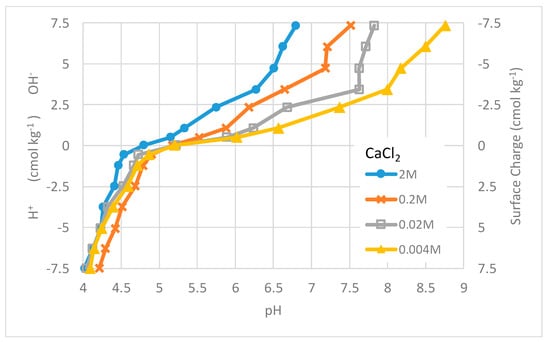
Figure 3.
Point of zero charge for soils located in study area.
Figure 3 shows a typical point of zero charge for the soils of “Cerrado Biome” (pH = 5.2). Above the surface charge is negative and below it, the surface charge becomes positive [29].
Soils from the study area can be classified from an engineering point of view as residual soils, as they were developed in situ by the weathering of igneous, sedimentary, and metamorphic rocks. The mineral grains of residual soils should remain in the same position or at least have little movement relative to the position in which there were in the parent material during the weathering process. Residual soils are more prevalent in the tropics than elsewhere. In the tropical environment, chemical and biochemical weathering of the underlying material have much more influence on the residual soil formation process than in temperate and cold climates, where physical weathering prevails. Thus, under the name residual soils, an engineer might expect a wide range of different types of soils derived from different parent materials (igneous, sedimentary, and metamorphic rocks) presenting different conditions of soil mineralogy, morphology, climate, and degrees of weathering. Depending on the region, residual soils also receive different names, such as lateritic soils, laterites, latosols, saprolitic soils, black cotton soils, tropical soils, etc. The situation is further complicated by the fact that various investigators have given to the terms laterite, latosol, and lateritic soils so many connotations that they have become almost meaningless [29,32].
Table 1 presents the results of the granulometric analysis of the soil of Sites 1 and 2. The soil in the area was classified as a sandy soil, which is erosion prone, and erosion control measures needed to be put in place before the implementation of any additional engineering works.

Table 1.
Results of the granulometric analysis.
2.4. Materials
Drainage bioswales were installed in 20 experimental parcels with different types of revetments. Each bioswale had a trapezoidal cross section with a top width, bottom width and height of 1.5 m, 0.6 m and 0.5 m, respectively, and a length of 10 m. Eleven experimental parcels were installed in Site 1 (São Gonçalo do Abaeté), and nine in Site 2 (Córrego Dantas). Each experimental parcel was planted with seeds of the following species: Urochloa umidicola, Urochloa decumbens, Hypharrenia rufa, Crotalaria juncea, Melinis minutiflora, and Avena strigose. A total of six commercially available rolled erosion control products (RECPs) from three different manufacturers (Deflor [33], Maccaferri [34], and Tensar [35]) and one RECP that was specifically developed for this study—the preseeded reinforcement mat—were used as swale revetments in the experimental parcels:
- (a)
- Preseeded reinforcement mat (PSRM)—this revetment was developed specifically for this project. Its fabric is made with coconut fiber intertwined with two polypropylene networks by means of a longitudinal seam, and included seeds, organic adhesives, and a granulated chemical fertilizer. This geotextile, when moistened, promotes the germination and establishment of vegetation that will constitute the lining of the swale (Figure 4). It has a weight/area ratio of 500 g/m2. Its lifespan is 12 months.
 Figure 4. Swale with preseeded mat—Site 1: (a) immediately after implementation and (b) 90 days after implementation.
Figure 4. Swale with preseeded mat—Site 1: (a) immediately after implementation and (b) 90 days after implementation. - (b)
- High performance turf reinforcement mat (HPTRM) W3000 (Tensar)—this product is made with polypropylene monofilaments stabilized against UV radiation, forming a corrugated fabric in a three dimensional structure (Figure 5). It has a weight/area ratio of 500 g/m2 and a lifespan of 15 years.
 Figure 5. Swale with Tensar reinforcement mat W3000 revetment—Site 1: (a) immediately after implementation and (b) 90 days after implementation.
Figure 5. Swale with Tensar reinforcement mat W3000 revetment—Site 1: (a) immediately after implementation and (b) 90 days after implementation. - (c)
- Erosion control rolled reinforcement mat, Fibrax 400 BF (Deflor)—this product’s fabric is made with coconut fiber intertwined with 2 layers of polypropylene by means of longitudinal seams (Figure 6). It has a weight/area ratio of 400 g/m2 and a lifespan of 18 months.
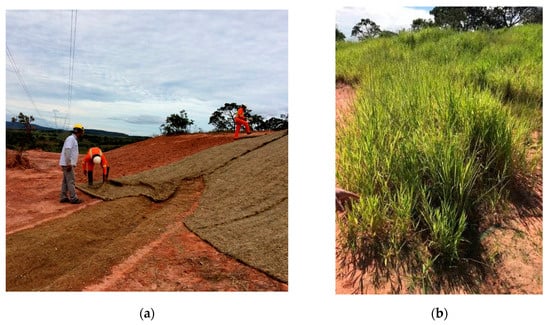 Figure 6. Swale with Deflor mat Fibrax 400 BF revetment—Site 1: (a) immediately after implementation and (b) 90 days after implementation.
Figure 6. Swale with Deflor mat Fibrax 400 BF revetment—Site 1: (a) immediately after implementation and (b) 90 days after implementation. - (d)
- Erosion control rolled geomat, Macmat (Maccaferri)—this geotextile is flexible as it has thick polypropylene filaments which are fused and spaced throughout the contact points of the fabric (Figure 7). It consists of about 90% voids. It has a weight/area ratio of 500 g/m2 and a lifespan of 10 years.
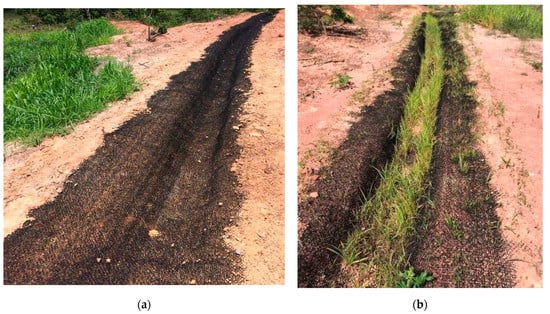 Figure 7. Swale with geomat Macmat—Site 1: (a) immediately after implementation and (b) 90 days after implementation.
Figure 7. Swale with geomat Macmat—Site 1: (a) immediately after implementation and (b) 90 days after implementation. - (e)
- Erosion control rolled geomat, MacMatR3 (Maccaferri)—in addition to what is described in item d), this product has an extra layer of polyester fabric (Figure 8). It has a weight/area ratio of 500 g/m2 and a lifespan of 10 years.
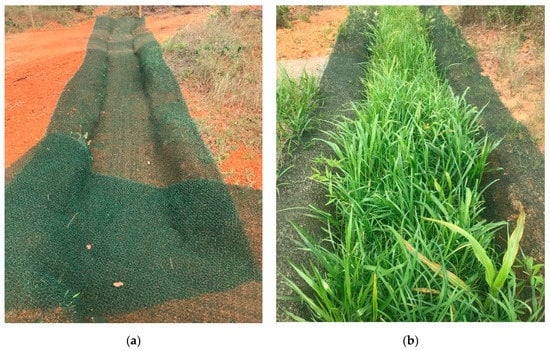 Figure 8. Swale with geomat Macmat R3—Site 2: (a) immediately after implementation and (b) 90 days after implementation.
Figure 8. Swale with geomat Macmat R3—Site 2: (a) immediately after implementation and (b) 90 days after implementation. - (f)
- Erosion control rolled reinforcement mat, MacMat R (Maccaferri)—this RECP geomat consists of about 90% voids and is fabricated with thick filaments of polypropylene. In addition, it has a metallic reinforcement in the form of a double twisted hexagonal mesh (Figure 9). Its lifespan is 20 years.
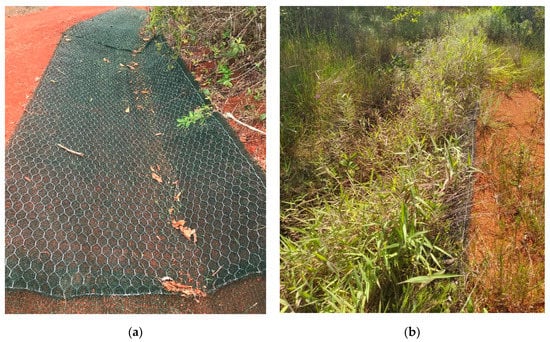 Figure 9. Swale with Maccaferri geomat MacMat R revetment—Site 2: (a) immediately after implementation and (b) 90 days after implementation.
Figure 9. Swale with Maccaferri geomat MacMat R revetment—Site 2: (a) immediately after implementation and (b) 90 days after implementation. - (g)
- Geogrid Triton 1500 BX (Tensar)—this geogrid is made with monofilaments of polypropylene stabilized against UV radiation. It has a weight/area ratio of 500 g/m2 and a lifespan of 15 years.
In addition to the individual performances of the first six RCEPs listed above (a–f), the combined performances of the Geogrid Triton 1500BX plus the preseeded reinforcement mat (Figure 10), and the Geogrid Triton 1500BX plus the Deflor’s Mat Fibrax 400 BF (Figure 11) were also evaluated. In these two cases, the Geogrid Triton was added as a turf reinforcement to increase the revetment’s shear strength. All RCEPs were anchored to the swale lining by using organic adhesives and steel clamps, CA-60, in an inverted “U” shape with dimensions of 4.2 mm × 200 mm (diameter × length).
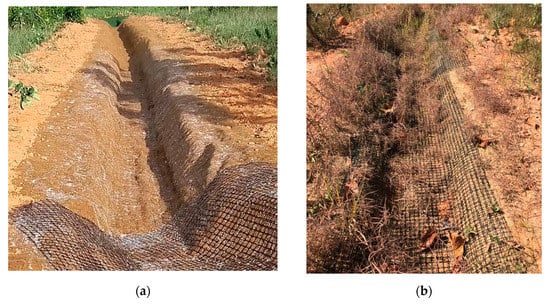
Figure 10.
Swale with preseeded mat and Tensar Geogrid Triton 1500 BX revetment—Site 1: (a) immediately after implementation and (b) 90 days after implementation.
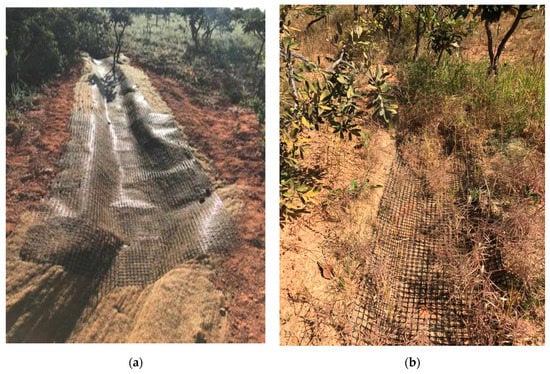
Figure 11.
Swale with Deflor Mat Fibrax 400 BF + Tensar Geogrid Triton 1500 BX revetment—Site 2: (a) immediately after implementation and (b) 90 days after implementation.
2.5. Methods
To evaluate the performance of the experimental parcels, a performance index is proposed based on five performance indicators: (1) the number of plant species that developed in the swale; (2) the dry biomass of the vegetation developed on each swale bed; (3) the structural integrity of each swale; (4) the vegetative cover level of the swale; and (5) the occurrence of erosive processes in the swale surfaces, around them, and immediately downstream of these drainage systems. For each of these performance indicators, a weight varying from 0 to 2 was assigned, and then the performance index of each one of the bioswale revetments investigated was defined as the sum of all performance indicator weights. Table 2, below, describes each parameter in detail, where the higher the weight (indicator of performance), the better the overall performance. For cost effectiveness analysis, the implementation cost of each of the parcels was compared to the implementation cost of a concrete lined swale, which is defined as the cost ratio (implementation unit area cost of swales with RECPs, divided by implementation cost of a concrete lined swale).

Table 2.
Performance indicators.
Vegetation sampling for the biomass was obtained by randomly selecting from areas of about 40 x 60 cm2, oriented toward the flow direction of the swale. From these randomly selected areas, all exposed (above ground) vegetation was sampled for biomass calculations. Immediately after sampling, the aerial biomass was labeled, weighed and bagged. After the drying process at the laboratory, the biomass was weighed again to estimate the biomass of each parcel according to procedures defined by Quincozes et al. [36].
The identification of the vegetation species present on each experimental parcel was carried out over the entire length of the swale (10 m), according to the databank from the International Plant Name Index [37], Missouri Botanical Garden [38], and Brazilian Flora [39], and it adopted the circumscription of the botanical families as proposed by the angiosperm phylogeny group classification—APG IV [40]. The performance evaluation was completed 48 months after the installation, to evaluate long term integrity and vegetation growth in the bioswale.
3. Results
Table 3, below, shows the performance of each revetment of the swales in Sites 1 and 2, 48 months after implementation. The timeframe for performance assessment was selected to allow for the bioswales to be exposed to four dry and four wet seasons, based on the authors’ 20 years of experience working with the bioengineering of soils. The greatest vegetation biodiversity developed within the swales was observed for the experimental parcels 5 (preseeded mat + Geogrid Triton 1500 BX), 9 (Deflor Mat Fibrax 400 BF), 13 (Deflor Mat Fibrax 400 BF + Tensar Triton 1500 BX), and 14 (Geomat Macmat), with at least 10 different species, which might have been brought to the swales by wind and/or animals, and were not part of the initial experiment. It is important to note that from the originally planted species, the species Urochloa umidicola and Avena strigose were not present after 48 months of implantation, while Melinis minutiflora was present in 16 out of the 20 parcels. The other three species, Urochloa decubens, Hypharrenia rufa and Croatalaria juncea, were present in 8 out of the 20 parcels. Similarly notably, there were four species (Setaria sp., Echinolaena inflexa, Megathyrsus maximus, and Stylosanthes macrocephala) that were not planted but were present in at least 25% of the parcels. Finally, it seems that the organic decay of the geomat materials may have also helped the growth of these species inside the bioswales, since the soils are acidic and have low fertility.

Table 3.
Performance results after 48 months.
In terms of overall performance, parcels 2 (preseeded mat), 10 (Deflor Fibrax 400 BF), 13 (Deflor Mat Fibrax 400 BF + Tensar Triton 1500 BX), 14 (Geomat Macmat), 17 (Geomat MacMat R3), 18 (Geomat MacMat R3), 19 (Geomat MacMat R) and 20 (Geomat MacMat R) had the highest performance index, with values of 9, 9, 10, 10, 9, 9, 9 and 9, respectively. Parcels 2 (preseeded mat) and 10 (Deflor Fibrax 400 BF) also had the lowest implementation cost (materials and labor), with a cost ratio (defined as the ratio of RECP cost to the concrete revetment cost per unit area) of 0.19 and 0.22, respectively, as shown in Figure 12. However, the damage level was higher in these two parcels; therefore, long-term performance may be compromised.
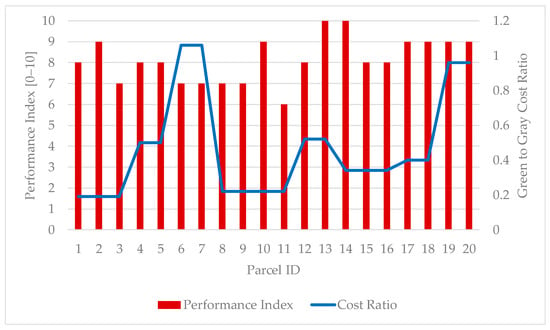
Figure 12.
Comparison of performance index and green to gray cost ratio for all experimental parcels in Sites 1 and 2.
Figure 13 shows the correlations between the type of vegetative cover, structural integrity and dry biomass of the 20 experimental parcels located in Study Sites 1 and 2. As expected, the structural integrity (measured as percent damage) of swales was inversely proportional to the vegetative cover percentage, with a Pearson correlation factor of −0.51.
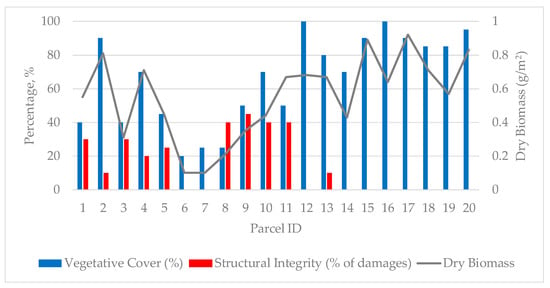
Figure 13.
Correlation between vegetative cover, structural integrity (measured as % damage) and dry biomass for the treatments of all experimental parcels in Sites 1 and 2.
4. Discussion and Conclusions
The performances of the seven RECPs used as erosion control revetments for drainage swales were evaluated using five performance indicators: (1) biodiversity; (2) dry biomass of the vegetation; (3) structural integrity of swale revetment; (4) vegetative cover; and (5) the occurrence of erosive processes.
In terms of biodiversity, the swale revetments with polypropylene materials presented a low performance in terms of biodiversity inside the swales, in particular those treated to protect against UV radiation. On the other hand, it was observed that parcels 5 (preseeded mat + Geogrid Triton 1500 BX), 9 (Fibrax mat), 13 (Fibrax mat + Geogrid Triton), and 14 (Macmat mat) presented the highest number of species. Out of the originally planted species, the species Urochloa umidicola and Avena strigose were not present after 48 months of implantation, while Melinis minutiflora was present in 16 out of the 20 parcels. The other three species, Urochloa decubens, Hypharrenia rufa and Croatalaria juncea, were present in 8 out of the 20 parcels. Similarly notably, there were four species (Setaria sp., Echinolaena inflexa, Megathyrsus maximus, and Stylosanthes macrocephala) that were not planted but were present in at least 25% of the parcels. In general, RECPs with a high opening in the mat had better performances in terms of biomass and vegetative growth, likely because openings made it easier for vegetation to grow.
Parcels 13 (Deflor Mat Fibrax 400 BF + Tensar Triton 1500 BX) and 14 (Geomat Macmat) had the highest performance index, with minimal to no damage observed, and with an implementation cost ratio of 0.32 and 0.54, respectively.
When both performance index and cost ratio are considered, Parcels 2 (preseeded mat) and 10 (Deflor Fibrax 400 BF) had the best cost benefit, which means a lower cost ratio and higher performance index. The innovative preseeded mat developed during this research presented great potential for utilization in the revetment of swales, with the advantage that it is already preseeded by the manufacturer. In general, RECPs were less expensive than concrete lining, while providing the inherent environmental benefits of bioswales, such as increased infiltration, reduced stormwater runoff flow, increased carbon sequestration, and increased groundwater recharge. Additionally, transport and installation of RECPs is usually simpler when compared to concrete, especially in areas with difficult access such as the remote sites where transmission line towers are usually installed.
Furthermore, the preseeded reinforcement mat presented some advantages over conventional RECPs, since it requires fewer materials during installation and a simpler implementation procedure, since the seeds and fertilizers needed for the growth and development of vegetation are included as part of the mat matrix. In addition, the adhesive layer used to fix the seeds to the mat creates a semi-impermeable layer that protects the structural integrity of the bioswale bed, allowing for the initial development and growth of the vegetation.
In conclusion, results have indicated that the implementation of bioswales was a successful and economical solution as a stormwater management system, and RECPs demonstrated great potential for use as a swale revetment under tropical conditions. The proper choice of seeds and type of RECPs can provide organic matter for the top soil horizon, consequently increasing its soil water capacity retention (which is very important in the long dry season of this study area), improve soil fertility and diminish the inherent soil acidity by increasing its pH, thus providing the desirable conditions for vegetation growth not only of the planted seeds, but also the ones transported by wind, humans and animals, as evidenced in this project.
Author Contributions
Conceptualization, A.T.C. and J.F.T.C.; methodology, A.T.C., T.C.d.B.G., G.B.M.; formal analysis, G.B.M., T.C.d.B.G., A.T.C.; investigation, A.T.C., T.C.d.B.G.; writing—original draft preparation, A.T.C., T.C.d.B.G., G.B.M.; writing—review and editing, T.C.d.B.G., G.B.M.; supervision, A.T.C. and J.F.T.C.; project administration, A.T.C. and J.F.T.C.; funding acquisition, A.T.C. and J.F.T.C. All authors have read and agreed to the published version of the manuscript.
Funding
This research was funded by the Agência Nacional de Energia Elétrica (ANEEL; GT-0581) and performed in collaboration with CEMIG GT—Geração e Trasmissão.
Institutional Review Board Statement
Not Applicable.
Informed Consent Statement
Not Applicable.
Acknowledgments
The authors would like to thank the CEMIG GT—Geração e Transmissão for being a proponent of the research project; ANEEL for providing the financial support, and NSF CREST Center for Energy and Sustainability (NSF #1547723) at California State University Los Angeles; and all of the CEMIG GT community for the support provided to the research activities reported in this paper. Any opinions, findings, and conclusions or recommendations expressed in this material are those of the author(s) and do not necessarily reflect the views of the funding agencies.
Conflicts of Interest
The authors declare no conflict of interest. The funders had no role in the design of the study; in the collection, analyses, or interpretation of data; in the writing of the manuscript, or in the decision to publish the results.
References
- Pennino, M.J.; McDonald, R.I.; Jaffé, P. Watershed-scale impacts of stormwater green infrastructure on hydrology, nutrient fluxes, and combined sewer overflows in the mid-Atlantic region. Sci. Total Environ. 2016, 565, 1044–1053. [Google Scholar] [CrossRef] [Green Version]
- Harbor, J. Engineering geomorphology at the cutting edge of land disturbance: Erosion and sediment control on con-struction sites. Geomorphology 1999, 31, 247–263. [Google Scholar] [CrossRef]
- Wise, S. Green infrastructure rising. Planning 2008, 74, 14–19. [Google Scholar]
- Tota-Maharaj, K.; Scholz, M. Efficiency of permeable pavement systems for the removal of urban runoff pollutants under varying environmental conditions. Environ. Prog. Sustain. Energy 2010, 29, 358–369. [Google Scholar] [CrossRef]
- Casal-Campos, A.; Fu, G.; Butler, D.; Moore, A. An integrated environmental assessment of green and gray infra-structure strategies for robust decision making. Environ. Sci. Technol. 2015, 49, 8307–8314. [Google Scholar] [CrossRef] [PubMed] [Green Version]
- Cohen, J.P.; Field, R.; Tafuri, A.N.; Ports, M.A. Cost comparison of conventional gray combined sewer overflow control infrastructure versus a green/gray combination. J. Irrig. Drain. Eng. 2012, 138, 534–540. [Google Scholar] [CrossRef]
- USEPA. What Is Green Infrastructure? US Environmental Protection Agency 2017. Available online: https://www.epa.gov/green-infrastructure/what-green-infrastructure (accessed on 1 August 2017).
- Bloorchian, A.A.; Ahiablame, L.; Zhou, J.; Osouli, A. Performance Evaluation of Combined Linear BMPs for Reducing Runoff from Highways in an Urban Area. In World Environmental and Water Resources Congress 2016; American Society of Civil Engineers (ASCE): Reston, VA, USA, 2016; pp. 20–29. [Google Scholar]
- Bertrand-Krajewski, J.-L.; Chebbo, G.; Saget, A. Distribution of pollutant mass vs volume in stormwater discharges and the first flush phenomenon. Water Res. 1998, 32, 2341–2356. [Google Scholar] [CrossRef]
- Lee, H.; Lau, S.-L.; Kayhanian, M.; Stenstrom, M. Seasonal first flush phenomenon of urban stormwater discharges. Water Res. 2004, 38, 4153–4163. [Google Scholar] [CrossRef]
- Taebi, A.; Droste, R.L. First flush pollution load of urban stormwater runoff. J. Environ. Eng. Sci. 2004, 3, 301–309. [Google Scholar] [CrossRef]
- Anderson, B.S.; Phillips, B.M.; Voorhees, J.P.; Siegler, K.; Tjeerdema, R. Bioswales reduce contaminants associated with toxicity in urban storm water. Environ. Toxicol. Chem. 2016, 35, 3124–3134. [Google Scholar] [CrossRef] [PubMed]
- Xiao, Q.; McPherson, E.G.; Zhang, Q.; Ge, X.; Dahlgren, R. Performance of two bioswales on urban runoff man-agement. Infrastructures 2017, 2, 12. [Google Scholar] [CrossRef] [Green Version]
- Shetty, N.H.; Hu, R.; Mailloux, B.J.; Hsueh, D.Y.; McGillis, W.R.; Wang, M.; Chandran, K.; Culligan, P.J. Studying the effect of bioswales on nutrient pollution in urban combined sewer systems. Sci. Total Environ. 2019, 665, 944–958. [Google Scholar] [CrossRef]
- Yang, H.; Spoonamore, S. Stormwater runoff treatment using Bioswales augmented with advanced nanoengineered materials. In Aquananotechnology: Global Prospects; CRC Press: Boca Raton, FL, USA, 2012; pp. 661–680. [Google Scholar]
- Lucas, S.; Clar, M.L.; Gracie, J. A Green Street Retrofit in a Chesapeake Bay Community Using Bioswales. In Low Impact Development Technology: Implementation and Economics; American Society of Civil Engineers (ASCE): Reston, VA, USA, 2015; pp. 81–90. [Google Scholar] [CrossRef]
- Vogel, J.R.; Moore, T.L.; Coffman, R.R.; Rodie, S.N.; Hutchinson, S.; McDonough, K.; McLemore, A.J.; McMaine, J.T. Critical Review of Technical Questions Facing Low Impact Development and Green Infrastructure: A Perspective from the Great Plains. Water Environ. Res. 2015, 87, 849–862. [Google Scholar] [CrossRef]
- Kavehei, E.; Jenkins, G.A.; Adame, M.F.; Lemckert, C. Carbon sequestration potential for mitigating the carbon footprint of green stormwater infrastructure. Renew. Sustain. Energy Rev. 2018, 94, 1179–1191. [Google Scholar] [CrossRef]
- Nickel, D.; Schoenfelder, W.; Medearis, D.; Dolowitz, D.; Keeley, M.; Shuster, W. German experience in managing stormwater with green infrastructure. J. Environ. Plan. Manag. 2013, 57, 403–423. [Google Scholar] [CrossRef]
- Kirby, J.T.; Durrans, S.R.; Pitt, R.; Johnson, P.D. Hydraulic Resistance in Grass Swales Designed for Small Flow Conveyance. J. Hydraul. Eng. 2005, 131, 65–68. [Google Scholar] [CrossRef]
- Sartor, J.; Mobilia, M.; Longobardi, A. Results and findings from 15 years of sustainable urban storm water man-agement. Int. J. Saf. Secur. Eng. 2018, 8, 505–514. [Google Scholar]
- McFarland, A.R.; Larsen, L.; Yeshitela, K.; Engida, A.N.; Love, N.G. Guide for using green infrastructure in urban environments for stormwater management. Environ. Sci. Water Res. Technol. 2019, 5, 643–659. [Google Scholar] [CrossRef]
- Mazer, G.; Booth, D.; Ewing, K. Limitations to vegetation establishment and growth in biofiltration swales. Ecol. Eng. 2001, 17, 429–443. [Google Scholar] [CrossRef]
- McCollough, S.; Ring, T. Electrical Transmission Lines in Montana: Mitigation of Impacts to Soil and Biological Sources. In Proceedings of the Billings Symposium on Disturbed Land Rehabilitation, Billings, MT, USA, 25–30 March 1990; Available online: https://www.osti.gov/biblio/56925 (accessed on 1 January 2021).
- Iqbal, M.F.; Khan, I.A. Spatiotemporal Land Use Land Cover change analysis and erosion risk mapping of Azad Jammu and Kashmir, Pakistan. Egypt. J. Remote Sens. Space Sci. 2014, 17, 209–229. [Google Scholar] [CrossRef] [Green Version]
- Köppen, W.; Geiger, R. Klimate der Erde; Verlag justus perthes: Gotha, Germany, 1928; pp. 91–102. [Google Scholar]
- Júnior, A.D.S.; Carvalho, L.G.; Da Silva, F.F.; Alves, M.D.C. Application of the Köppen classification for climatic zoning in the state of Minas Gerais, Brazil. Theor. Appl. Clim. 2011, 108, 1–7. [Google Scholar] [CrossRef]
- Climate Data. 2020. Available online: http://climate-data.org (accessed on 15 July 2020).
- De Brito Galvão, T.C. Mineralogical and Geotecnical Properties of a Latosol from Minas Gerais, Brazil. Ph.D. Dissertation, Purdue University, West Lafayette, Indiana, (Diss. Abstr. 94-20816). 1993. [Google Scholar]
- Galvão, T.C.D.B.; Schulze, D.G. Mineralogical Properties of a Collapsible Lateritic Soil from Minas Gerais, Brazil. Soil Sci. Soc. Am. J. 1996, 60, 1969–1978. [Google Scholar] [CrossRef]
- Munsell Color (Firm). Munsell Soil Color Charts: with Genuine Munsell Color Chips; Munsell Color: Grand Rapids, MI, USA, 2010. [Google Scholar]
- De Brito Galvão, T.C.; Drnevich, V.P.; Schulze, D.C. Chemical, Mineralogical, and compressibility characteristics of a collapsible lateritic soil from Minas Gerais, Brazil. In Proceedings of the Unsaturated soils/sols non saturés—Proceedings of the 1st International Conference on Unsaturated Soils, Unsat 95, Balkema, Rotterdam, 6–8 September 1995; Alonso, E.E., Delage, P., Eds.; pp. 39–44. [Google Scholar]
- Deflor, Biomantas Antierosivas. Available online: http://deflor.com.br/biomanta-fibrax/ (accessed on 14 April 2021).
- Maccaferri, Geomantas–MacMat. 2021. Available online: https://www.maccaferri.com/br/produtos/geomantas-macmat (accessed on 14 April 2021).
- Tensar: Erosion Control Products Brochure. 2012. Available online: https://pdf.archiexpo.com/pdf/tensar-international/tensar-erosion-control-brochure/63203-234206.html (accessed on 14 April 2021).
- da Quincozes, E.R.F.; Vargas, L.M.; Scivittaro, W.B.; De Mello, J.M.; Bandeira, D.L. Embrapa (in Portuguese)–Foliar Analysis System–User Manual. 2007. Available online: https://www.embrapa.br/busca-de-publicacoes/-/publicacao/745893/sistema-de-analise-foliar-manual-do-usuario EMBRAPA (accessed on 17 June 2019).
- Garden, M.B. Tropicos.org. 2011. Available online: Http://www.Tropicos.Org (accessed on 20 August 2019).
- MBGPF. Missouri Botanical Garden. 2019. Available online: http://www.missouribotanicalgarden.org/plantfinder/plantfindersearch.aspx (accessed on 1 December 2019).
- Flora do Brasil. Rio de Janeiro Botanic Garden (in Portuguese). 2020. Available online: http://floradobrasil.jbrj.gov.br/ (accessed on 17 June 2020).
- Chase, M.W.; Christenhusz, M.; Fay, M.; Byng, J.; Judd, W.S.; Soltis, D.; Mabberley, A.N.; Sennikov, P.S.; Stevens, P.F. An update of the angiosperm phylogeny group classification for the orders and families of flowering plants: APG IV. Bot. J. Linn. Soc. 2016, 181, 1–20. [Google Scholar]
Publisher’s Note: MDPI stays neutral with regard to jurisdictional claims in published maps and institutional affiliations. |
© 2021 by the authors. Licensee MDPI, Basel, Switzerland. This article is an open access article distributed under the terms and conditions of the Creative Commons Attribution (CC BY) license (https://creativecommons.org/licenses/by/4.0/).